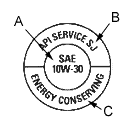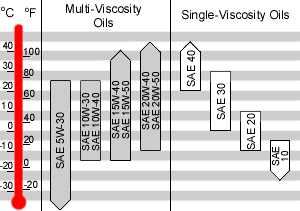
| |
- Capacity: 5.3 quarts (5.0 liters)
- Capacity includes filter. Always check dipstick level while filling. Do not overfill!
- Use API Service SG or SJ motor oil.
- Add oil until the level on the dipstick is at 'maximum,' run the engine to operating temperature, turn off engine, let sit for 30 seconds, and recheck and correct oil level if necessary.
What to look for on a motor oil label:
There are several different standards bodies around the world that evaluate motor oil; I will cover the SAE standard here because it is (as I understand it) the most widely used. If anyone wants to explain other standards (such as the ACEA standards) I would not mind putting the explanation here.
 The first thing that you'll want to look for is the 'API donut,' which tells you three
things:
The first thing that you'll want to look for is the 'API donut,' which tells you three
things:
- The text in the middle ('A') gives the SAE (Society of Automotive Engineers) viscosity grade, which is a measure of thickness. The numbers range from 0 to 50 in increments of 5; lower numbers indicate a thinner oil and higher numbers indicate a thicker oil. If there is a single number, the oil is a single grade oil; if you see two numbers separated by a dash the oil is a multigrade oil. Multigrade oil, for example 10W-30, is designed to have the viscosity characteristics of the first SAE number (SAE 10 in this example) oil at cold temperatures, and the viscosity characteristics of the second SAE number (SAE 30 in this example) at engine operating temperatures. The 'W' or 'Winter' (not 'Weight') designation indicates that the oil meets viscosity requirements for low temperatures (below 30°F or 0°C).
- The text on the top ('B') is the API (American Petroleum Institute) Service Rating. This two-letter classification identifies the vehicle fuel type that the oil is designed for. Ratings beginning with an 'S' are intended for gasoline engines, and ratings that begin with a 'C' are for diesel engines. The second letter designates the quality of the oil -- the higher the letter, the more protection the oil offers your engine. As a general rule, a higher letter can be used if a lower letter is recommended, i.e. an SJ oil can be used in any engine requiring an SB, SG, or SH oil.
- The text on the bottom ('C') will either say 'Energy Conserving' or nothing -- oils that are energy conserving are formulated with friction modifiers to improve fuel economy in an industry standard test.
 The International Lubricant Standardization and Approval Committee (ILSAC) created a
symbol for the front of the oil bottle that indicates an oil meets both the latest
performance category (currently SL), and the Energy Conserving standard. This
is a good seal to see printed on the label of your oil.
The International Lubricant Standardization and Approval Committee (ILSAC) created a
symbol for the front of the oil bottle that indicates an oil meets both the latest
performance category (currently SL), and the Energy Conserving standard. This
is a good seal to see printed on the label of your oil.
So what weight to choose?
First, think of a single grade oil (i.e. SAE 5: a thin, low-viscosity oil). Low-viscosity oils flow better than high-viscosity oils because the lighter-weight fluid is easier for your engine's oil pump to move around. Even though a larger volume of low-viscosity oil will be pumped by your engine, the lighter fluid maintains a lower oil pressure. High-viscosity oils tend to make the engine operate at higher temperatures because the oil pump has to work harder to push it through the system -- since the oil does not compress easily, the higher oil pressures increase the oil temperature.
The common perception of multigrade oils is that they are merely a blend of two different oil weights, but this is not the case. Multigrade oils begin as a base oil, such as SAE 5. Viscosity-index modifiers (polymers) are added to stabilize the viscosity over a wide range of temperatures -- this allows an SAE 10W-40 oil to flow like an SAE 10 oil at cold temperatures, and an SAE 40 oil at higher temperatures. The polymers are long-chain molecules that lessen the oil's tendency to change viscosity with temperature changes. This is good because at cold temperatures, a lower viscosity is better because it is easier to pump around (cold oil becomes thick, so starting with a thinner oil means that as it thickens it is still relatively easy to pump); at high temperatures a high viscosity oil is better (as the oil temperature increases, it gets thinner).
Single-weight oils are less common now because they cannot pass the low-temperature viscosity test (to get a 'W' added to the viscosity rating) -- by definition, an oil that passes the low-temperature viscosity test qualifies as a multigrade oil.
 Having said all of that, you don't really need to know any of this to make a reasonable
decision. in your owner's manual, you will find a handy chart (displayed here) that
gives you the answer.
Your best bet is to think of the temperature ranges that your engine is likely to see in
the next 5000 miles (8000 km), and see where that range fits on the chart. This chart
uses the terms 'multi-viscosity' and 'single viscosity,' which are technically incorrect
(an oil cannot be multi-viscosity), but overall it is a good reference. However do not
treat it as gospel -- if you find that on cold mornings your engine is very noisy before
it warms up, use oil with a lower low-temperature viscosity (the number with the 'W'); if
you find that in very hot weather your engine oil pressure drops significantly, use an
oil whose high-temperature viscosity rating (without the 'W') is higher.
Having said all of that, you don't really need to know any of this to make a reasonable
decision. in your owner's manual, you will find a handy chart (displayed here) that
gives you the answer.
Your best bet is to think of the temperature ranges that your engine is likely to see in
the next 5000 miles (8000 km), and see where that range fits on the chart. This chart
uses the terms 'multi-viscosity' and 'single viscosity,' which are technically incorrect
(an oil cannot be multi-viscosity), but overall it is a good reference. However do not
treat it as gospel -- if you find that on cold mornings your engine is very noisy before
it warms up, use oil with a lower low-temperature viscosity (the number with the 'W'); if
you find that in very hot weather your engine oil pressure drops significantly, use an
oil whose high-temperature viscosity rating (without the 'W') is higher.
I will not address synthetic oils or synthetic blend oils on this page. In fact, I will not touch that argument with a 10-foot pole. Some people prefer synthetic oils; some people will use nothing else, and others won't let them near their engine. All I will say is that if you have a high mileage engine, you should continue using whatever type of oil (synthetic or not) that you have used in the past.
|
|